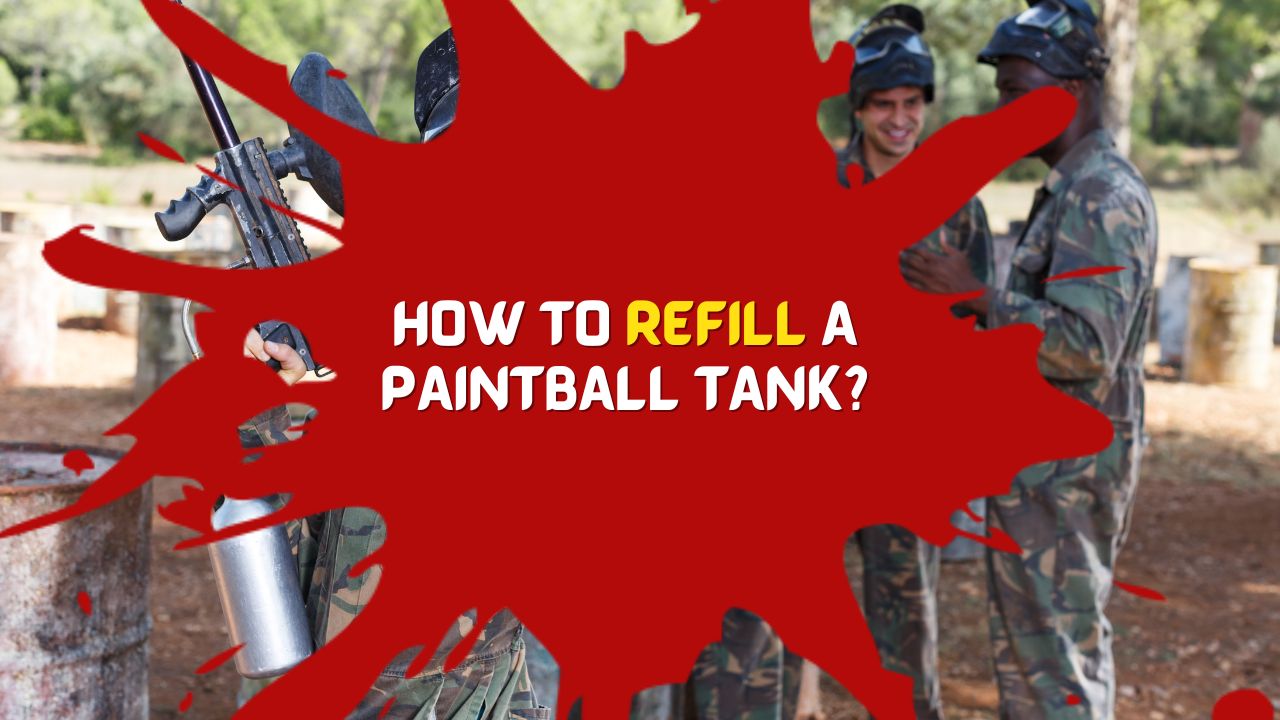Paintball is a thrilling sport that demands precision and strategy, and the heart of the action lies in the paintball tank. Whether you’re a newbie to the paintball world or an experienced player, understanding how to refill a paintball tank is a fundamental skill that ensures your marker’s optimal performance on the field. In this comprehensive guide, we’ll walk you through the process step by step, covering both CO2 and HPA (high-pressure air) tanks, and provide you with essential safety tips to guarantee a seamless and secure tank refill.

Understanding Paintball Tank Refilling
Before we dive into the specifics of the refill process, let’s get a grasp of the basics when it comes to paintball tanks and their refilling requirements.
CO2 Tanks
CO2 tanks, or carbon dioxide tanks, are a popular choice among paintball players due to their affordability and accessibility. However, it’s important to be cautious during the refill process, as CO2 expands with temperature changes. This can lead to overfilling and safety hazards if not managed properly.
HPA Tanks
HPA tanks, also known as compressed air tanks, provide a more consistent and reliable performance compared to CO2 tanks. They require specialized equipment and should be refilled only by certified professionals.
Steps to Refill a Paintball Tank
Refilling a paintball tank involves several crucial steps to ensure both your safety and the proper functioning of your marker. Below, we’ll outline the step-by-step process for refilling both CO2 and HPA tanks.
Refilling a CO2 Paintball Tank
Gather the Necessary Equipment
- CO2 paintball tank
- Certified CO2 fill station
- Protective gloves
- Safety goggles
Attach the Tank to the Fill Station
- Wear protective gloves and safety goggles to ensure your safety during the process.
- Align the tank’s valve with the fill station’s nozzle.
- Secure the tank onto the fill station by turning it clockwise.
Slowly Fill the Tank
- Open both the valve on the CO2 tank and the valve on the fill station.
- Begin filling the tank slowly to prevent overfilling, which can lead to safety issues and suboptimal marker performance.
- Keep an eye on the pressure gauge on the fill station to ensure you reach the appropriate pressure level (typically measured in PSI – pounds per square inch).
Close Valves and Detach the Tank
- Once the tank is adequately filled, close the valves on both the CO2 tank and the fill station.
- Gently release any remaining pressure in the fill station’s hose by briefly opening the valve.
- Carefully detach the tank from the fill station by turning it counterclockwise.
Check for Leaks
- After detaching the tank, inspect it for any signs of leaks, such as hissing sounds or visible gas escaping. Address any leaks before proceeding.
Refilling an HPA Paintball Tank
Choose a Certified Refill Station
- Locate a certified paintball or scuba shop that offers high-pressure air refills.
- Ensure the shop has the necessary equipment and expertise to safely refill HPA tanks.
Prepare the Tank
- Make sure your HPA tank is in good condition and within its hydrostatic testing date.
- Remove any attachments, such as the regulator, from the tank.
Hand Over the Tank
- Hand your HPA tank over to the shop’s trained personnel for proper and safe refilling.
Refill Process
- The staff at the shop will utilize specialized equipment to refill your HPA tank to the appropriate pressure level.
- The time it takes to refill the tank may vary based on its size and the shop’s equipment.
Test the Tank
- Before leaving the shop, request a pressure test to ensure your tank is correctly filled and safe to use during gameplay.
Safety Precautions During Tank Refilling
Your safety is paramount when dealing with high-pressure tanks. By following these safety precautions, you’ll minimize risks and ensure a secure refilling experience.
Wear Protective Gear
- Always put on protective gloves and safety goggles before handling paintball tanks during the refill process.
Avoid Overfilling
- When dealing with CO2 tanks, fill them gradually to avoid overfilling, which can lead to leaks and safety hazards.
- HPA tanks should only be refilled by professionals at certified facilities to prevent accidents.
Inspect for Damage
- Thoroughly inspect your tank before refilling it. Look for any signs of dents, cracks, or other damage that could compromise its integrity.
Prevent Exposure to Heat
- Keep your paintball tanks away from high temperatures and direct sunlight. Excessive heat can cause pressure increases and potential safety risks.
Frequently Asked Questions (FAQs)
1. Can I refill my paintball tank at home?
Refilling paintball tanks at home is not recommended, especially for HPA tanks. CO2 tanks can be refilled at home, but it requires specialized equipment and a thorough understanding of safety protocols.
2. How often should I refill my paintball tank?
The frequency of refilling depends on factors like tank size, rate of fire, and temperature. CO2 tanks may need more frequent refills due to temperature fluctuations affecting the gas’s expansion.
3. Are there any dangers associated with refilling paintball tanks?
Yes, mishandling tanks can lead to leaks, overfills, and potential hazards. Following safety precautions and relying on certified professionals for HPA tank refills is crucial.
4. What’s the difference between CO2 and HPA tanks?
CO2 tanks use carbon dioxide, which expands in warm temperatures, affecting pressure consistency. HPA tanks use compressed air, offering more consistent performance and safety.
5. Can I fill an HPA tank with CO2 or vice versa?
No, CO2 and HPA tanks require different refilling procedures and equipment. Attempting to fill a tank with the wrong gas can damage the tank and pose safety risks.
Mastering the Art of Tank Refilling
Refilling a paintball tank may seem daunting initially, but with the knowledge and precautions provided in this guide, it becomes a manageable task. Whether you’re dealing with CO2 or HPA, following the outlined steps and adhering to safety guidelines ensures a safe and efficient tank refill process.
